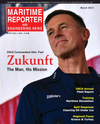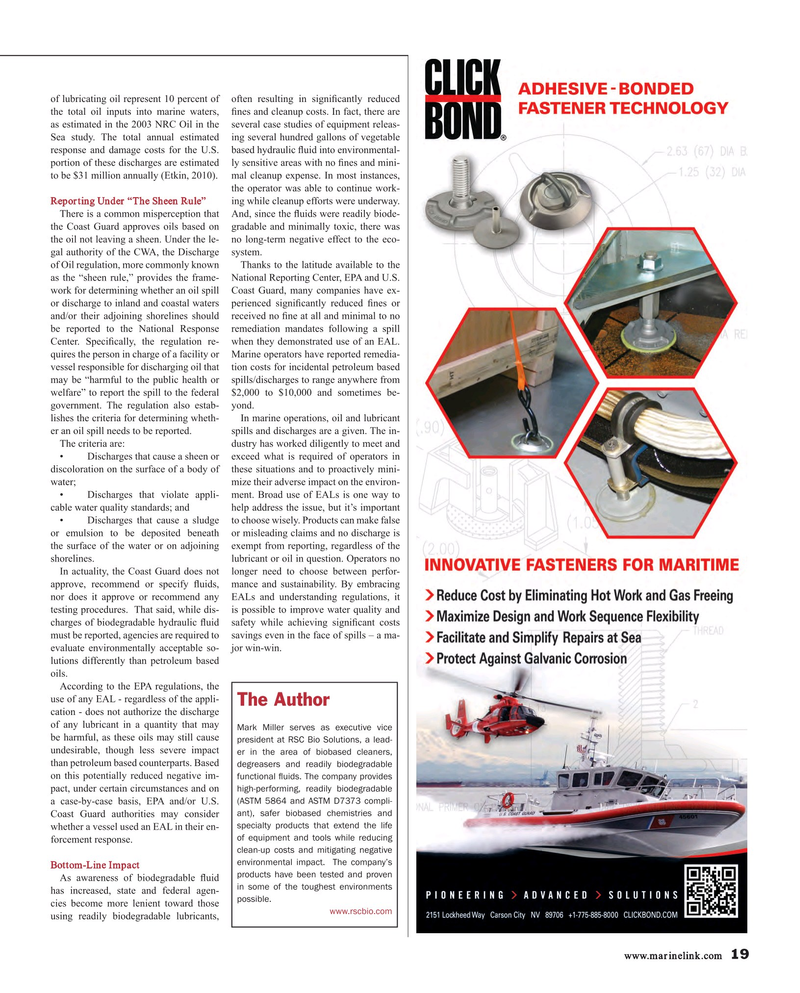
Page 19: of Maritime Reporter Magazine (March 2015)
U.S. Coast Guard Annual
Read this page in Pdf, Flash or Html5 edition of March 2015 Maritime Reporter Magazine
of lubricating oil represent 10 percent of often resulting in signi? cantly reduced the total oil inputs into marine waters, ? nes and cleanup costs. In fact, there are as estimated in the 2003 NRC Oil in the several case studies of equipment releas-
Sea study. The total annual estimated ing several hundred gallons of vegetable response and damage costs for the U.S. based hydraulic ? uid into environmental- portion of these discharges are estimated ly sensitive areas with no ? nes and mini- to be $31 million annually (Etkin, 2010). mal cleanup expense. In most instances, the operator was able to continue work-
Reporting Under “The Sheen Rule” ing while cleanup efforts were underway.
There is a common misperception that And, since the ? uids were readily biode- the Coast Guard approves oils based on gradable and minimally toxic, there was the oil not leaving a sheen. Under the le- no long-term negative effect to the eco- gal authority of the CWA, the Discharge system.
of Oil regulation, more commonly known Thanks to the latitude available to the as the “sheen rule,” provides the frame- National Reporting Center, EPA and U.S. work for determining whether an oil spill Coast Guard, many companies have ex- or discharge to inland and coastal waters perienced signi? cantly reduced ? nes or and/or their adjoining shorelines should received no ? ne at all and minimal to no be reported to the National Response remediation mandates following a spill
Center. Speci? cally, the regulation re- when they demonstrated use of an EAL. quires the person in charge of a facility or Marine operators have reported remedia- vessel responsible for discharging oil that tion costs for incidental petroleum based may be “harmful to the public health or spills/discharges to range anywhere from welfare” to report the spill to the federal $2,000 to $10,000 and sometimes be- government. The regulation also estab- yond. lishes the criteria for determining wheth- In marine operations, oil and lubricant er an oil spill needs to be reported. spills and discharges are a given. The in-
The criteria are: dustry has worked diligently to meet and • Discharges that cause a sheen or exceed what is required of operators in discoloration on the surface of a body of these situations and to proactively mini- water; mize their adverse impact on the environ- • Discharges that violate appli- ment. Broad use of EALs is one way to cable water quality standards; and help address the issue, but it’s important • Discharges that cause a sludge to choose wisely. Products can make false or emulsion to be deposited beneath or misleading claims and no discharge is the surface of the water or on adjoining exempt from reporting, regardless of the shorelines. lubricant or oil in question. Operators no
In actuality, the Coast Guard does not longer need to choose between perfor- approve, recommend or specify ? uids, mance and sustainability. By embracing nor does it approve or recommend any EALs and understanding regulations, it testing procedures. That said, while dis- is possible to improve water quality and charges of biodegradable hydraulic ? uid safety while achieving signi? cant costs must be reported, agencies are required to savings even in the face of spills – a ma- evaluate environmentally acceptable so- jor win-win.
lutions differently than petroleum based oils.
According to the EPA regulations, the use of any EAL - regardless of the appli-
The Author cation - does not authorize the discharge of any lubricant in a quantity that may
Mark Miller serves as executive vice be harmful, as these oils may still cause president at RSC Bio Solutions, a lead- undesirable, though less severe impact er in the area of biobased cleaners, than petroleum based counterparts. Based degreasers and readily biodegradable on this potentially reduced negative im- functional ? uids. The company provides high-performing, readily biodegradable pact, under certain circumstances and on (ASTM 5864 and ASTM D7373 compli- a case-by-case basis, EPA and/or U.S. ant), safer biobased chemistries and
Coast Guard authorities may consider specialty products that extend the life whether a vessel used an EAL in their en- of equipment and tools while reducing forcement response.
clean-up costs and mitigating negative environmental impact. The company’s
Bottom-Line Impact products have been tested and proven
As awareness of biodegradable ? uid in some of the toughest environments has increased, state and federal agen- possible. cies become more lenient toward those www.rscbio.com using readily biodegradable lubricants, www.marinelink.com 19
MR #3 (18-25).indd 19 MR #3 (18-25).indd 19 3/3/2015 9:58:48 AM3/3/2015 9:58:48 AM

 18
18

 20
20
